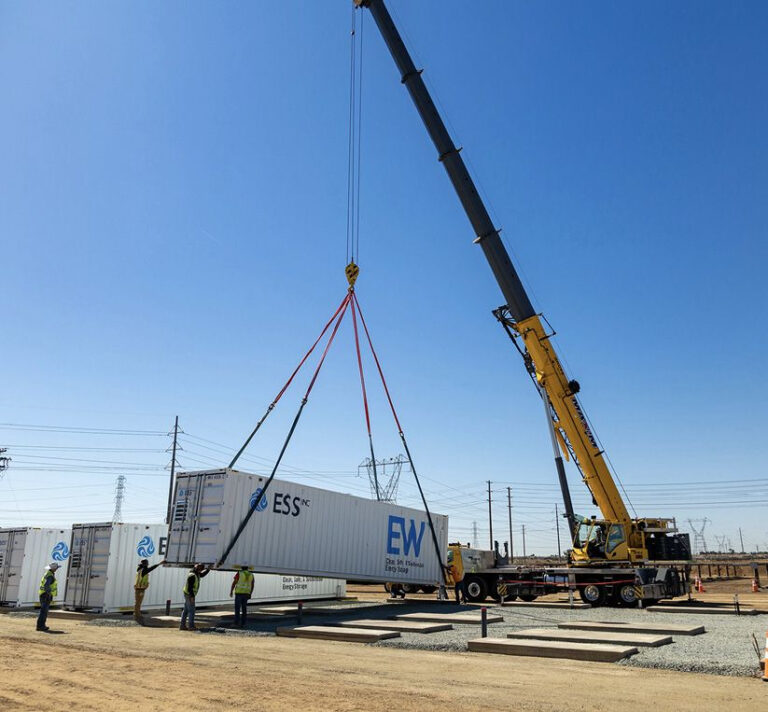There is a gap in the market for long-term energy storage (LDES), according to the American manufacturer ESS Inc.-one that cannot be connected with lithium-ionchemia. Hugh McDermott, from Ess Inc. tells PV Magazine how he thinks Iron stream batteries fit in the energy system of the future, while the company is striving for global expansion.
From PV Magazine 2/25
Think about how the energy sector has developed for more than 150 years. There are worry and intermediate power plants that work at intervals to meet the periods of a high demand for electricity and there are baseload plants that continuously generate. A variety of technology has been used to match with loading profiles. The generation mix is diverse.
“They are horses for courses,” said Hugh McDermott, Vice-President (VP) of Business Development at ESS Inc. Early to the Business Case for the long -term iron batteries of ESS Inc. PV -Magazine that LDES plays a role and offers value “in every energy market that is renewable [energy] Goals. “
“Every energy market that has a zero-cabbage goal … Simple Physics says you can’t get there with two and four hours of batteries,” he said.
Founded in 2011, the American Ess Inc. LDES systems for applications in the field of utilities and commercial scale. The company claims that its Iron Flow LDES technology can store on-demand up to 12 hours, “sendable” energy, has unlimited loading and discharge cycle lifespan and a lifespan of 25 years. In contrast to the lithium-ionchemia that has dominated the implementation of energy storage on Utility scale, the iron stream batteries of ESS Inc. Play in the baseload room, according to McDermott. “Fundamentally what we do is transform intermittent renewable energy into baseload energy,” he said.
Breaking Ground
On the basis of the base in Wilsonville, Oregon, Ess Inc. The production capacity of the type plate of “just shy of a gigawatt hour” per year, according to McDermott. The Senior VP added that there is potential to extend to about 6 GWh on the site, and the company has ambitions in that direction. “The pace of this will be powered by the order behind and pipeline,” he said.
Ambition is supported by substantial financing, thanks in part to a package of $ 50 million supplied by the export-import bank of the United States of America and announced in June 2024.
Furthermore, Ess Inc. Made movements in Australia. The company established in the US works together with Local Business Energy Storage Industries (ESI) to set up a production operation that has successfully protected the support of the state. A factory in the installation has protected AUD 25 million ($ 15.5 million) in financing the government of Queensland, plus Aud 40 million in private capital.
When operational, the Australian factory will assemble Iron Flow LDES systems using battery modules, electrolyte and other core components of ESS Inc., with remaining parts from local supply chains, according to McDermott. Battery modules must be sent from Oregon to Queensland in the first quarter of 2025.
Ess Inc. Hopes by the end of 2026 200 MW/1.6 GWH Iron stream battery production capacity to establish in the Australian factory, which looks up to 400 MW/3.2 GWh in 2029.
Next stop Europe?
Just like Australia, Europe has shown the implementation of renewable energy sources and battery energy storage system (BESS). Can Ess Inc. -Batteries will soon also be manufactured east of the Atlantic Ocean?
“Without a doubt,” said McDermott. “Whether in the UK, whether it is Ireland, whether it is on the continent, we will no doubt, it is just a matter of time before we have an assembly facility somewhere [in Europe]. “
Decide when and where ESS Inc. In Europe will produce, it is due to market forces, McDermott explains, and it is likely that the model will be comparable to what is located in Australia – working together with a local operation.
“It’s a kind of chicken and egg,” said McDermott. “It is logical that as soon as there is sufficient demand, or at least visibility for the question, we are willing to make the investment. [In Australia] We saw a strong question and we pulled the trigger to formalize our local partnership. “
The long display
Like all new technologies, investing in LDEs comes with certain risks. According to McDermott’s opinion, however, LDES is essential for the energy transition and the state can play a role in risk investments. He emphasized that the Cap-and-Floor mechanism that was introduced for LDEs in the United Kingdom, as an example of the way in which governments can support the implementation of energy storage.
“For example, [the UK government] Introduces a CAP-and-Floor mechanism to stimulate investments in long-term energy storage, “he said. Interesting and structures are needed for newer technology to overcome an observed technology risk for investors.
Iron stream batteries are at least not completely new technology. McDermott emphasized existing ESS Inc. -Installations in multiple markets such as proof of concept. The company has already supplied a 1 MW/10 MWH Iron Flow battery to a site next to Stanwell Power Station, in a deal with Queensland’s state -owned company Stanwell Corp.
Closer to Home, Ess Inc. Has a partnership with Global Conglomane Honeywell. That deal, announced for the first time in 2023, saw Honeywell $ 27.5 million in shares of ESS Inc. buy. It offered Ess Inc. Also access to the intellectual property of Honeywell’s Flow Battery, as well as a business relationship with a large potential customer. McDermott said that the design phase of a large project for Honeywell ended at the end of 2024. The goal is to develop a design that can be used for Gigawatt scale installations.
This content is protected by copyright and may not be reused. If you want to work with us and reuse part of our content, please contact: editors@pv-magazine.com.


